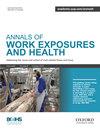208a - Workplace health without borders: its mission, vision and impact from training
IF 1.8
4区 医学
Q3 PUBLIC, ENVIRONMENTAL & OCCUPATIONAL HEALTH
引用次数: 0
Abstract
Workplace Health Without Borders (WHWB) is an international non-profit focused on Occupational Health/Industrial Hygiene for underserved workers. Our mission is to prevent work-related disease and injury through the sharing of expertise, knowledge, and skills. Sharing our knowledge globally through training was hindered during the pandemic. This presentation outlines how we pivoted to online training, delivered training in three different languages, and found new partners to help us perform occupational health and safety training. We will share the story of the online training process we pioneered that used a combination of asynchronous study with synchronous tutorials. This process allowed the students who normally had full time jobs to study at their own pace, followed by attending weekly tutorials. These tutorials were led by professionals in the field of occupational safety and health from various locations around the world. This presentation will provide lessons learned from evaluations, the impact of the training, how we overcame obstacles and what our plans are for the future. It will also discuss how good partners are essential to this process and most importantly how to focus on what your students need and want.208a - 工作场所健康无国界:培训的使命、愿景和影响
工作场所健康无国界组织(WHWB)是一家国际非营利组织,致力于为得不到充分服务的工人提供职业健康/工业卫生服务。我们的使命是通过分享专业技术、知识和技能来预防与工作有关的疾病和伤害。通过培训在全球范围内分享我们的知识在大流行病期间受到了阻碍。本讲座将概述我们如何转向在线培训,如何以三种不同的语言提供培训,以及如何找到新的合作伙伴帮助我们开展职业健康与安全培训。我们将分享我们首创的在线培训流程的故事,该流程将异步学习与同步辅导相结合。这一过程允许通常从事全职工作的学员按照自己的进度学习,然后参加每周一次的辅导。这些辅导课程由来自世界各地的职业安全与健康领域的专业人士主讲。本报告将介绍从评估中吸取的经验教训、培训的影响、我们如何克服障碍以及未来的计划。它还将讨论良好的合作伙伴对这一过程的重要性,以及最重要的是如何关注学生的需要和愿望。
本文章由计算机程序翻译,如有差异,请以英文原文为准。
求助全文
约1分钟内获得全文
求助全文
来源期刊

Annals Of Work Exposures and Health
Medicine-Public Health, Environmental and Occupational Health
CiteScore
4.60
自引率
19.20%
发文量
79
期刊介绍:
About the Journal
Annals of Work Exposures and Health is dedicated to presenting advances in exposure science supporting the recognition, quantification, and control of exposures at work, and epidemiological studies on their effects on human health and well-being. A key question we apply to submission is, "Is this paper going to help readers better understand, quantify, and control conditions at work that adversely or positively affect health and well-being?"
We are interested in high quality scientific research addressing:
the quantification of work exposures, including chemical, biological, physical, biomechanical, and psychosocial, and the elements of work organization giving rise to such exposures;
the relationship between these exposures and the acute and chronic health consequences for those exposed and their families and communities;
populations at special risk of work-related exposures including women, under-represented minorities, immigrants, and other vulnerable groups such as temporary, contingent and informal sector workers;
the effectiveness of interventions addressing exposure and risk including production technologies, work process engineering, and personal protective systems;
policies and management approaches to reduce risk and improve health and well-being among workers, their families or communities;
methodologies and mechanisms that underlie the quantification and/or control of exposure and risk.
There is heavy pressure on space in the journal, and the above interests mean that we do not usually publish papers that simply report local conditions without generalizable results. We are also unlikely to publish reports on human health and well-being without information on the work exposure characteristics giving rise to the effects. We particularly welcome contributions from scientists based in, or addressing conditions in, developing economies that fall within the above scope.
 求助内容:
求助内容: 应助结果提醒方式:
应助结果提醒方式:


